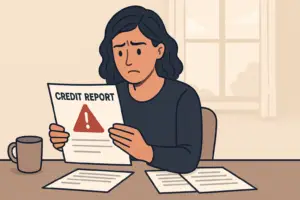When you think about identity theft do you picture a computer hacker sitting alone in a dark room, surfing the internet hoping to find a bank account with an easy password? Some criminals are loners, but you may be surprised to learn about some of the more aggressive tactics identity thieves use to steal innocent consumers’ hard-earned money.
Some identity thieves prey on trusting consumers who are led to believe there is a problem with their financial accounts. When facing a banking problem, most people will accept help when offered. Our client, “Brian” was targeted and fell victim to a clever identity thief who claimed he was an Amazon security representative.
Beware of Customer Service Representatives Who Ask to See Your Computer Screen
The fraudster told Brian his Amazon account showed unauthorized transfers. The thief offered to help clear up the problem and said Amazon would credit $200 to Brian’s account. To transfer the credit, the thief requested a computer screenshot which then gave the thief access to Brian’s computer. The thief took control of Brian’s computer, transferred $11,500 out of Brian’s savings account into his checking account, then locked Brian out of his computer and withdrew $18,500 from Brian’s checking account.
Brian saw the transfers and immediately contacted his personal bank, Citibank. The thief’s transfer instructions and Brian’s fraud notification all occurred after the close of business, so nothing was processed that day.
How Some Banks Respond to Customers’ Disputes
The following day, the unauthorized transfer was sent despite Brian’s cancellation request. That same day, the fraudster tried to access Brian’s account again and when he was unsuccessful, the criminal remotely disabled Brian’s computer. Brian went to his local Citibank office in person to file a fraud report.
The next day, Citi confirmed that Brian’s funds were transferred to a bank in Thailand and immediately withdrawn from that account. During the next two days, Brian filed a police report and FBI complaint and gave both to Citi along with an affidavit. One day later, Citi told Brian his case was closed, Citi would not do anything to help, and if Brian wanted any relief, he would have to take legal action.
However, five days later, Brian received a text from Citi asking him to verify the fraudulent transfer. Brian again said the transfer was not authorized. A Citi representative told Brian the investigation was being reopened, but the next day Brian was told his case was closed again.
Citi confirmed that the overseas transfer request and Brian’s cancellation were received on the same day but concluded that the funds were no longer in the Thailand account so they couldn’t be returned to Brian. At first, Citi acknowledged that Brian was the victim of identity thieves but still refused to return the stolen money. Later, Citi changed its story and claimed that Brian did not safeguard his account and compromised his account security, so he contributed to the theft.
Ironically, Citi agreed to refund $35 to Brian’s account. This amount was for the wire transfer fee Citi assessed against Brian for the unauthorized overseas transfer that happened after Brian tried to cancel the thief’s withdrawal.
Is There Protection for Identity Thieves’ Victims?
Modern society relies on technology to get through daily life. American consumers use electronic banking every day and expect banks to protect their funds from criminal hackers. Unfortunately, some financial institutions simply won’t help identity theft victims until confronted by a consumer protection lawyer or a court order.
The federal government passed the Electronic Funds Transfer Act (EFTA) in 1978 to protect consumers’ rights when they transfer money electronically. The EFTA also limits how much a consumer can lose in a fraud situation and clarifies what a bank must do when an account holder disputes a transaction.
What Should a Victim Do? What Must a Bank Do?
In general, identity theft victims like Brian should report the theft to the authorities and notify the bank as soon as possible once the theft is discovered. The EFTA provides different levels of consumer protection depending on when the bank receives notice from the account holder. To receive maximum protection under the law, file a report on the same day or within two business days.
In our case, Brian did exactly what he was supposed to do under his circumstances. Once notified about the theft, the bank must take certain steps under the EFTA.
Specifically, Citibank should not have made the fraudulent transfer that Brian canceled on the same day. Also, Citi should have issued a provisional credit of $18,500 into Brian’s account, and it should have performed a thorough investigation of the circumstances.
Based upon Brian’s evidence, including the police report and FBI complaint, as well as Brian’s account history that showed no large overseas transfers in the past, Citi should have agreed that the large withdrawal was unauthorized. Also, as one of the world’s largest banking corporations, Citibank should have been aware of this scam scenario and realized this type of overseas transfer was a common crime, not an authorized transfer. Citi should have returned Brian’s money.
What Can Schlanger Law Group Do When Identity Thieves Strike?
Most of our clients are innocent identity theft victims who try to resolve the situation on their own, but their bank won’t help. That’s when we jump into action. We are passionate about protecting consumers who have been victimized not only by identity thieves but also by big banking corporations that don’t care about their account holders.
If you have lost money from an unauthorized electronic transfer and your bank refuses to help, contact the team at Schlanger Law Group for a free case consultation. Our vast EFTA litigation experience shows that we’re not afraid to take on big companies to protect individual rights. Call us today at (212) 500-6114 or fill out our quick online form to schedule an appointment today.







